OVERVIEW
When the U.S. won the Spanish-American War it annexed the former Spanish colony of Puerto Rico, as part of the December 10, 1898 Treaty of Paris. This ended four centuries of Spanish rule, but essentially substituted one master for another.
Here is a brief history of that relationship.
1897
FREE AT LAST
Spain grants Puerto Rico a Carta de Autonomía (Charter of Autonomy) which, after four hundred years, would give Puerto Rico its independence.
1898
EIGHT DAYS OF INDEPENDENCE
General elections are held in March 1898 and the first “autonomous”government of Puerto Rico begins to function on July 17, 1898.
Just eight days later, on July 25, Nelson A. Miles (the Commanding General of the U.S. Army) invades Puerto Rico with 16,000 soldiers as part of the Spanish-American War. This ends Puerto Rico’s independence.
Uncle Sam reaches out to Puerto Rico
1899
HURRICANE SAN CIRIACO
One of the worst Caribbean hurricanes in history, San Ciriaco kills over 3,400 Puerto Ricans and destroys the entire island coffee crop. U.S. hurricane relief is bizarre…
The U.S. sets up the American Colonial Bank, and the Spanish peso is replaced by the U.S. dollar as Puerto Rico’s currency. Though of equal international value, each peso isdeclared worth only 60 U.S. cents. This cripples the Puerto Rican economy, particularly for the small farmers.
1910
U.S. BANKS FORECLOSE ON PUERTO RICAN LAND
With crippled farms and 40% less wealth, Puerto Rican farmers have to borrow money from U.S. banks. With no usury law restrictions, the American Colonial Bank charges interest rates so high that, within a decade (by 1910), the farmers default on their loans, and the banks now own their land.
1917
U.S. CITIZENSHIP
In 1917 Woodrow Wilson signs the Jones Act, under which English is decreed the “official language” of Puerto Rico, and Puerto Ricans are granted U.S. citizenship.
This enables 18,000 Puerto Ricans to fight in World War I.
1st Puerto Rican Regiment
1921
MONCHO REYES, THE IDIOT GOVERNOR
U.S. President Warren Harding appoints Emmet Montgomery Reily as Governor of Puerto Rico. In turn, Reily places his own friends in prominent positions throughout the Puerto Rican government.
Reily decrees that the U. S. flag (“Old Glory”) will be the only flag used throughout the entire island. He also declares that Spanish will no longer be used in any schools, which will now teach exclusively in English.
Reily is extremely unpopular. Puerto Ricans nickname him Moncho Reyes (a “Moncho” is an uncivilized moron). He is forced to resign in 1923, under a growing cloud of corruption charges.
1920 – 1930
U. S. LAND GRAB
By 1930, all of Puerto Rico’s farms belong to 41 sugar syndicates. 80% of these are U.S. owned, and the largest four syndicates – Central Guanica, South Puerto Rico, Fajardo Sugar and East Puerto Rico Sugar – are entirely U.S. owned and cover over half the island’s arable land.
NO MINIMUM WAGE
With no money, no crops, and no land, Puerto Ricans seek work in the cities. When the Puerto Rican legislature enacts a minimum-wage law like the one in America, the U.S. Supreme Court declares it unconstitutional.
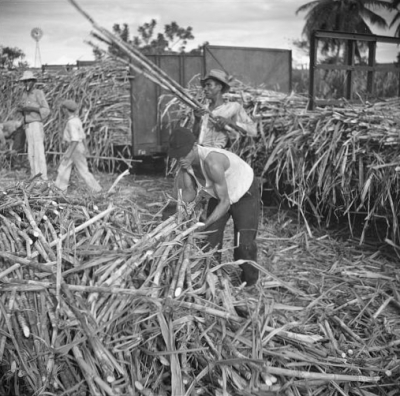
This decision is made despite AFL-CIO President Samuel Gompers’ testimony that “the salaries paid to Puerto Ricans are now less than half what they received under the Spanish.”
PRICES FIXED
U.S. finished products – from rubber bands to radios – are priced 15 to 20% higher on the island than on the mainland. Puerto Rico is powerless to enact any price-fixing legislation.
1930
PEDRO ALBIZU CAMPOS
Pedro Albizu Campos, the first Puerto Rican graduate of Harvard Law School, is elected as President of the Puerto Rican Nationalist Party. Immediately, he starts to organize the island’s agricultural workers and small farmers.
Don Pedro Albizu Campos
For a video about the life (and death) of Albizu Campos, see:
1931
PUERTO RICAN GUINEA PIGS
Pedro Albizu Campos investigates some disturbing rumors at San Juan Presbyterian Hospital, and confirms that a Dr. Cornelius P. Rhoads is injecting Puerto Rican patients with live cancer cells, and that he killed at least 13 of them.
A scandal erupts when the following letter, written by Dr. Rhoads himself, is discovered and released by Albizu Campos:
“The Porto Ricans (sic) are the dirtiest, laziest, most degenerate and thievish race of men ever to inhabit this sphere…I have done my best to further the process of extermination by killing off eight and transplanting cancer into several more…All physicians take delight in the abuse and torture of the unfortunate subjects.”
The U.S. press hail Dr. Rhoads, and place him on the cover of Time Magazine.

1930 – 1970
MASS STERILIZATION
Puerto Rican women are massively used for the testing of I.U.D.’s and birth control pills. In addition, between 1930 and 1970, approximately one-third of Puerto Rico’s female population of childbearing age undergo “the operation,” the highest rate in the world.
Many of these women were “operated” upon without their knowledge or consent. Most frequently, these “procedures” occurred immediately after childbirth.
The Human Betterment Association of America promotes Eugenics (a thinly-veiled version of Nazi racial cleansing) as a basis for sterilizing blacks in the U.S. mainland, and Puerto Ricans on the island.
The available research and documentation of this colonial genocide is extensive.
Here is a robust bibliography: http://womenst.library.wisc.edu/bibliogs/puerwom.htm
1934
LOS MACHETEROS GO ON STRIKE
Pedro Albizu Campos directs an island-wide agricultural strike. The sugarcane workers, or Macheteros, get a few wage concessions from the sugar syndicates.
This is the first time that anyone organizes Puerto Ricans against the United States…and wins.

24-HOUR FBI SURVEILLANCE OF ALBIZU CAMPOS
The U.S. economy is in a Great Depression. It needs every economic advantage it can find. Because of the Machetero sugarcane strike, the Puerto Rican Nationalist Party is targeted as a “threat to national security” and Albizu Campos’s life is in danger.

Albizu Campos speaking
J. Edgar Hoover orders 24-hour FBI surveillance of Campos’s movements and meetings. He receives constant death threats, is attacked in his own home, jailed for 24 years, beaten and tortured in prison.
1935
RIO PIEDRAS MASSACRE
In the town of Rio Piedras, at a student assembly of the University of Puerto Rico, police shoot and kill four members of the Puerto Rican Nationalist Party: José Barea, Ramón Pagán, Pedro Quiñones, and Eduardo Vega.
1936
ASSASSINATION OF POLICE CHIEF RIGGS
In retaliation for the Río Piedras massacre, the insular police chief E. Francis Riggs is murdered in San Juan. Two Nationalist Party members, Hiram Rosado and Elías Beauchamp, are immediately arrested and shot dead in the San Juan police headquarters.
1937
PONCE MASSACRE
On Palm Sunday, March 21, a peaceful march is held in the town of Ponce, in support of Pedro Albizu Campos and other Nationalists who were recently imprisoned.
The march turns into a bloody police slaughter, killing 18 unarmed Puerto Ricans and wounding over 200 others. Women and children are killed – including a 7-year old girl, who is shot in the back.
The massacre occurs under the direct military command of General Blanton Winship, the U.S.-appointed governor of Puerto Rico.
The Ponce Massacre
The police continue firing, even as dead bodies pile up in the street:

On April 14, U.S. Congressman Vito Marcantonio denounces Winship on the floor of U.S. Congress:
“In his five years as Governor of Puerto Rico, Mr. Blanton Winship destroyed the last vestige of civil rights in Puerto Rico. Patriots were framed in the very executive mansion and railroaded to prison. Men, women, and children were massacred in the streets of the island simply because they dared to express their opinion or attempted to meet in free assemblage.”
—Vito Marcantonio, U.S. Congressman
Congressional Record of April 14, 1937, page 4499
1939
BOMBING OF CULEBRA
The U.S. begins to use the Culebra Archipelago as a gunnery and bombing practice site.
1941
OCCUPATION OF VIEQUES
The U.S. establishes military bases in the islands of Vieques and Culebra. The Roosevelt Roads Naval Station is one of the largest naval facilities in the world covering 32,000 acres, three harbors, and two-thirds of the island of Vieques.
The Vieques bombing range
For over 60 years, the U.S. Navy uses Vieques for target practice in Navy bombing exercises. They use napalm, Agent Orange, and between 300 and 800 tons of depleted uranium-tipped ammunition. In total, the Navy drops nearly 3 million pounds of bombs on Vieques annually, until 2003.
Target practice at Vieques
Toward the end, as international pressure mounts against this bombing, the Governor of Puerto Rico appears before the U.S. Congress to say this:
“Never again shall we tolerate abuse of a magnitude and scope the likes of which no community in any of the fifty states would ever be asked to tolerate. Never again shall we tolerate such abuse: not for sixty years, and not for sixty months, or sixty hours, or sixty minutes.”
Puerto Rico Governor, Pedro Roselló, October 19, 1999
Statement before the U.S. Senate Armed Forces Committee
1948
LAW 53(THE GAG LAW)
Puerto Rico’s Gag Law (Law 53) is enacted to suppress the independence movement in Puerto Rico. The Gag Law makes it a crime to sing a patriotic tune; to speak or write of independence; or to meet with anyone, or hold any assembly, with regard to the political status of Puerto Rico. Anyone found guilty of disobeying this law is sentenced to ten years imprisonment, a fine of $10,000 dollars (US), or both.

Rally in defiance of the Gag Law
The Gag Law also makes it a crime to display or own a Puerto Rican flag – even in one’s own home. This “flag” provision allows police and National Guardsmen to: 1) enter anyone’s home without a warrant, and 2) search and seize all property, regardless of probable cause.
Since all Puerto Ricans were declared U.S. citizens in 1917 (in order to send 18,000 of them to fight in World War I), the Gag Law is in direct violation of the First Amendment of the U.S. Constitution, which guarantees freedom of speech to all U.S. citizens.

Mass arrests for violations of the Gag Law
Despite its constitutional flaws, the Gag Law is politically effective. 15 members of the Puerto Rican Nationalist Party are immediately arrested and accused of violating it, and mass arrests are threatened throughout the island.
The Gag Law is repealed in 1957.
1950
UPRISINGS THROUGHOUT PUERTO RICO
Organized and led by Pedro Albizu Campos, Puerto Ricans revolt in five towns (Jayuya, Utuado, Mayagüez, Naranjito, Arecibo) during a four-day period (Oct. 29 – Nov. 1), and attempt to assassinate both the President of the United States and the Governor of Puerto Rico.
JAYUYA UPRISING
On October 29, in the town of Jayuya, Puerto Rican Nationalists burn a post office, attack a police station, cut the telephone lines, raise a Puerto Rican flag (in defiance of the Gag Law), and declare Puerto Rico a free Republic.
The U.S. begs to differ.
They declare martial law and attack the town with U.S. bomber planes, land-based artillery, mortar fire, grenades, U.S. infantry troops, and the National Guard. The planes machine-gun nearly every rooftop in the town. The Nationalists manage to hold the town for three days, then mass arrests follow.
U.S. troops arrive in Jayuya (Oct. 30, 1950)
Even though an extensive part of Jayuya is destroyed, news of this military action is prevented from spreading outside of Puerto Rico. It is reported as an “incident between Puerto Ricans” by the American media.
UTUADO UPRISING
On October 30, in the town of Utuado, a group of 32 Nationalists attack the local police.
The fight goes badly. Twelve surviving men retreat to the house of Damián Torres – which is promptly strafed by 50-caliber machine guns, from four American P-47 Thunderbolt planes. Three men die from this aerial gunfire.
The National Guard arrives later that day, and orders the nine surviving Nationalists to surrender. When they do so, the nine men are taken to the Utuado police station and shot. Five of them (Heriberto Castro, Julio Feliciano, Agustín Quiñones Mercado, Antonio Ramos and Antonio González) die immediately, the other four are seriously wounded.
In the same manner as Jayuya, the massacre is reported as an “incident between Puerto Ricans” by the American media.
ATTACK ON THE GOVERNOR OF PUERTO RICO
On October 30, in San Juan, five Nationalists attack La Fortaleza (the Governor’s Mansion) in an attempt to assassinate Governor Luis Muñoz Marín. The battle lasts 15 minutes, leaving four Nationalists dead and three police officers wounded.
GUNFIGHT AT THE SALÓN BORICUA
On October 30, in the town of Santurce, forty armed police officers and National Guardsmen attack one man (Vidal Santiago Díaz) at his barbershop.
The attack is fierce and sustained – because the man is a Nationalist, and because he is Pedro Albizu Campos’s personal barber. Though Díaz is all alone, police use machine guns, rifles, carbines, revolvers, and even grenades.
The Gunfight at Salón Boricua becomes legendary. It lasts three hours, is transmitted live by radio, and heard all over the island. To the dismay of Governor Luis Muñoz Marín, the “little barber” becomes an overnight hero in Puerto Rico.
They got the barber
ATTACK ON PRESIDENT HARRY S. TRUMAN
On November 1, Nationalists Oscar Collazo and Griselio Torresola attempt to assassinate U.S. President Harry S. Truman. They attack the Blair House, where Truman is staying in Washington, D.C. The gunfight is short, less than one minute. Torresola and police officer Leslie Coffelt are killed, Oscar Collazo is sentenced to life imprisonment.
1954
ATTACK ON THE U.S. HOUSE OF REPRESENTATIVES
Four Nationalists enter the Ladies’ Gallery (a balcony for visitors) of the U.S. Capital, unfurl a Puerto Rican flag, shout “Que viva Puerto Rico libre!” and shoot at the 240 Representatives of the 83rd Congress. Five congresspersons are wounded, though none fatally.
Lolita Lebron under arrest
The Nationalists – Lolita Lebrón, Rafael Miranda, Andres Cordero, and Irving Rodríguez – are arrested and sentenced to 70 years imprisonment. Upon her arrest, Lebrón declares “I did not come to kill anyone, I came to die for Puerto Rico.”
This was a major story in 1954:

Decades later, Lolita Lebrón remains a political and fashion icon.
 1959
1959
CUBAN REVOLUTION CREATES MORE TOURISM
Immediately after the Cuban Revolution, which culminates in the overthrow of dictator Fulgencio Batista on January 1, 1959, the U.S tourism industry makes a massive shift to Puerto Rico. Hotels and casinos spring up, Pan Am flights multiply.
Even novelists Saul Bellow (teaching at the University of Puerto Rico), William Kennedy (editing the San Juan Star), and Hunter Thompson (writing for El Sportivo and the Herald Tribune) fly down and live cheap, during the late 50’s and early 60’s.
While stationed in Puerto Rico (1961-1963) John Kennedy Toole teaches English to Puerto Rican soldiers, drinks copiously, and writes the first draft of A Confederacy of Dunces.
1965
PEDRO ALBIZU CAMPOS DIES
Albizu Campos, the leader of the Puerto Rican Nationalist movement, dies in San Juan. He suffered his entire lifetime for his beliefs. He spent 23 years in prison. Most other years, he was under 24-hour surveillance by the FBI.
He was tear-gassed.
He was beaten in prison.
He was tortured and subjected to radiation in prison, until his limbs swelled grotesquely. (yes, you read this correctly)
The press inquires about radiation
He was finally released, after suffering a stroke in prison…on the brink of death.
He was semi-paralytic and mute, and died a few months later.
Che Guevara appeared before the United Nations, and said this about him:
“Albizu Campos is a symbol of America unredeemed, but indomitable. Years and years of prisons, mental torture, solitude, complete isolation from his family and his people, the insolence of the conqueror and its lackeys on the land that gave him birth…nothing broke his will. The Cuban delegation renders homage, admiration and gratitude to a patriot who has given dignity to our America.”
They carried Albizu Campos’s coffin through the streets of his hometown in Ponce.
His coffin was then transported to San Juan, where over 75,000 Puerto Ricans accompanied him to the Old San Juan Cemetery.
Today, Pedro Albizu Campos is honored throughout Latin America, with a moral standing and historical significance comparable to Simón Bolivar.
1971
CULEBRA ISLAND TAKEOVER
The U.S. Army takes possession of almost all of Culebra Island.
1976
IRS SECTION 936
Section 936 section of the United States Internal Revenue Tax Code allows U.S. companies to operate in the island without paying corporate taxes.
For the next 30 years, until 2006, American pharmaceutical companies take advantage of this tax loophole, to generate unprecedented profits.
1978
CERRO MARAVILLA
Pro-independence activists Carlos Arriví and Arnaldo Rosado are executed in a police ambush, in a mountain known as Cerro Maravilla. The subsequent cover-up involves the FBI and high-ranking members of the Puerto Rican government.
1980 – 2000
PHARMACEUTICAL BOOM
U.S. pharmaceutical corporations build enormous drug production facilities in Puerto Rico. The island becomes a pill factory.
As of 2008, Puerto Rico is the world’s largest shipper of pharmaceuticals, accounting for nearly 25% of total shipments. 16 of the 20 biggest-selling drugs in the U.S., are produced in Puerto Rico.
In the town of Barceloneta, one Pfizer factory produces all the Viagra consumed in North America (the U.S., Canada and Mexico).
In 2002, the combined profits for the ten drug companies in the Fortune 500 ($35.9 billion) were more than the profits for all the other 490 businesses combined ($33.7 billion).
2003
VIEQUES BOMBING STOPS
Bowing to international pressure, which intensifies after civilians are killed by stray bombs, the U.S. Navy ceases its 60-year bombing exercises on the island of Vieques.
2006
NO MORE IRS 936
IRS Section 936 is phased out and replaced by Section 30A, which essentially retains the 936 wage credit component. Pharmaceutical companies continue their enormous manufacture of drugs, and drug profits.
PRESENT
Today Puerto Rico’s unemployment rate is over 25 percent and per capita income is less than half that of Mississippi (the lowest of the fifty states). U.S. federal agencies control Puerto Rico’s foreign relations, customs, immigration, postal system, radio, TV, transportation, Social Security, military, maritime laws, banks, commerce, currency and defense.
The extent of military control over the island is particularly striking. One can’t drive five miles in any direction without running into an Army base, nuclear site or tracking station. The Pentagon controls 12 percent of Puerto Rico’s land and operates five atomic missile bases.
More than a century after its invasion by the U.S., Puerto Rico is one of the few classic colonies still in existence. Its “commonwealth” status is a thin veneer for a one-sided, abusive relationship.
The island is currently a pill factory – the world’s largest shipper of pharmaceuticals, accounting for nearly 25% of total shipments. 16 of the 20 largest-selling drugs in the U.S., are produced in Puerto Rico.
The profits made by these drug companies, roughly $35 billion annually, are greater than the combined budgets of every government in Puerto Rico – including all three branches of the central government; every public corporation, utility, and highway authority; and every municipality.
In 2009, Puerto Ricans had a median household income of $18,314. By comparison Mississippi, the poorest state in the U.S., had median household income of $36,646.
Clearly, the abusive relationship continues.
After 60 years of bombing in Vieques, a century of economic exploitation, a Gag Law, a land grab, the Ponce Massacre, the Rio Piedras Massacre, the execution of its leaders, and the sterilization of its women, Puerto Rico is not just a “commonwealth.”
It is the battered spouse of the Caribbean.


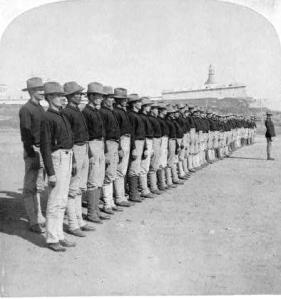



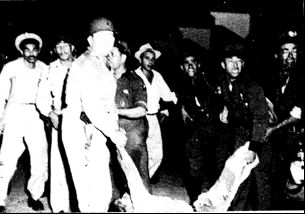
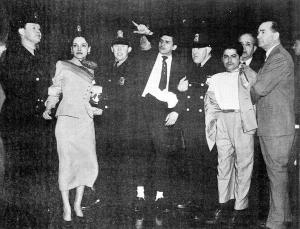

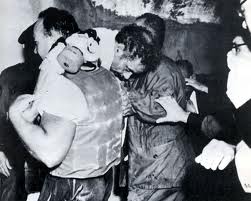
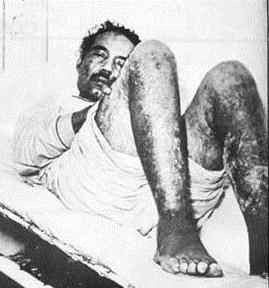




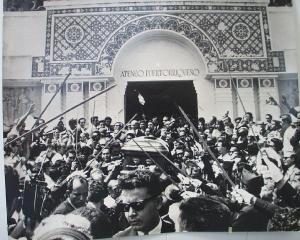
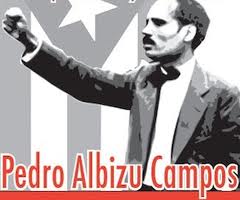
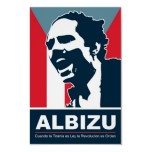


Alix
/ June 16, 2017Negatively, you and others are still living in the past 1898-today. Positive steps did take place, schools and medical building were established, agricultural growth helped the economy, disease control or eradication helped with mortality rates. Today millions have left the island searching to enrich their lives monetarily and living in the states. While others less fortunate need government assistance, housing, medical and subsidies. Where are the proud Puerto Rican people, where are the educated that can teach the children, where are the doctors that could provide medical services, where are the honest politicians that could look after the island and its people and where are the businessmen and women that could provide jobs. Hopefully, not in the shameful New York Puerto Rican parades. Look at the videos and let me know if you believe we have become more civilized since the 20th century. My last comment – all Puerto Ricans living in the states should give back to the island with their donation of time, services or money. *Nationalism is the first step to Communism.
Miguelon
/ September 12, 2021It is such past that have us in the actual present my dear friend.
It is what it is!
Sadly true!
Julio Noboa
/ March 12, 2016Estimado Denis: I am incredibly inspired by your book, as have many of my familia. Please send me your contact information so I could share and consult with you regarding a project related to Puerto Rico’s escudo or coat-of-arms which would be of particular interest to you and your readers.
Jose E Colom
/ August 20, 2015Fidel fought Batista and his murky army. Albizu confronted and fought against the mighty USA.
maije
/ February 7, 2015Tambien deberian de abundar del agente naranja que fue exparsido en los entrenamiento de las reservas del ejercito en uno de los campamentos Americanos del ejercito en PR
Pedro Santiago
/ December 5, 2014Gracias por su tiempo, afan, amor a nuestros origenes y su reverencia a aquellos que han sacrificado sus vidas por el mismo.
Antonio
/ December 3, 2014I live and work on my Finca in lovely Puerto Rico and have spent a good amount of my life actively learning about the history, culture and thought of Puerto Rico. Comments posted indicating first time knowledge of Puerto Rican History and its relations saddens me. While there is an incredible amount of loud, fervent pride in being Boricua, little effort is made to learn any meaningful history of Puerto Rico and its people. El Pueblo Boricua, in the US and the Island exercises little, if any, energy or action to change the horrible policies or practices that is narrated in this insightful column.
Tali Cruz
/ December 15, 2014I agree. Which is why some in NYC will look at me and question or say “you dont look Puerto Rican. This is because too many do not know their own history. It starts at home
My beloved mother kept her history alive and well
I am able to trace back my lineage 8 generations because my mother was responsible and full of pride and most of this history I knew. As a member of the Pizarro family de Santurce. . I Know who I am. Education should begin at home.
Ismael AcevedoI
/ November 25, 2014I am appalled and disgusted with the continued abuse at the hands of the USA. The Puerto Rican people need to become Politically strong and be a force in makng Boricua politically and financially independent
Tito Estrada
/ November 23, 2014Antonio Fernós Sagabien: Digno hijo de su digno Padre!!
David L Rojas Kalbach
/ November 23, 2014Antonio Fernos Sagebien, thanks for sharing this masterpiece with the rest of us. God bless you..
Unbelievable!! The story I always heard from great patriots and artists like Antonio Caban Vale, Andres Jimenez and many others, who were always stalked and spied by US authorities for speaking the naked truth. Born and raised by a Puerto Rican father and a Virginian mother in the mountains of this tropical paradise… Great grandson and descendant of fathers of this country like Jose Rojas Cortes, Leopoldo Rojas Flores and Leopoldo Rojas Reyes, I clearly and loudly express that this country’s people will never rest, will never quit, will never surrender until we are given either:
1) Full rights of representation before the U S congress and house of representatives.
Or
2) Let alone to decide our fate as a sovereign nation.
Stop draining our wealth.
Stop using our men and women to fight unjust causes, specially when they have no one to watch for their rights and benefits.
Stop forcing and imposing your laws and ridiculous trade impositions.
Stop starving our people to make them believe we depend on you.
Stop ignoring our decision, made democratically en 2012, to end the colonial status we presently live inand stop making yourselves ignorant of the unfair treatment and discrimination we face every day Vs all other US citizens.
Give us the same rights every other US citizens have. Otherwise, let us free for God’ sake and thosewsho love this beautiful country and the people who live in it…enough is enough!!
I will keep ponding the table each and every day of my life fir equality or independence…
“let not the lives of those who sacrificed before us, be in vain…”
Puerto Rican people should keep forcing the issue and action by the US government to decide to give Puerto Ricans the choice of full rights or free will.
This is my personal opinion…are you with me?
maria
/ November 23, 2014Gracias por este artiulo. Hay muchas cosas que yo no conocia. Aunque me causa dolor la manera como hemos sido tratados y manipulados , tambien me hace sentir orgullosa de ser Puertorriquena, una raza fuerte que ha sobrepasado las injusticias y el abuso, y sigue sintiendose orgullosa de ser Boricua.
Rafael Prado Cruz
/ November 23, 2014Thank you for an excellent work of journalism. I’ve lived in Puerto Rico since 1959, born in NYC, now 60… I would like to translate this work of yours to Spanish and hand it out to my friends and Family… I believe we don’t know half of Puerto RIcos’s history… It is really a shame that this type of work is not studied more deeply in our schools.. Rafael Prado
Anel
/ November 22, 2014It is a very interesting blog, however, it would be best to present references from reliable sources and/or any citations
Arturo Santiago
/ November 22, 2014This, yours, article on a perspective on the colonial repression of Puerto Ricans from the Spanish and to the United States, is in my view, extremely revealing on how we do not even know a lot or are unaware of the information about our peoples continuous struggles. It is also my concern that our youth maybe also be victims and unaware of where they come from, or if they do, have no knowledge on the whole story or our peoples. I thank you for the information you posed.
Both of my parents were Puerto Rican Patriots and Nationalist. My parents disapproved of being tagged as Independetista’s.
They always talked about the occurring injustices of the Puerto Ricans by the United States. They seemed to be well informed on the invents in Puerto Rico. I the 1950s they supported the uprisings in many of the towns and they respected and loved what Don Pedro Albizu Compos was saying. When Lolita Lebron and the other Nationalist attacked Blair House and the US Congress, my parents quietly supported their action. But were concerned that the FBI or other law enforcement groups may also target our family in New York City.
My mother, Petra Figueroa-Santiago was an activist for many years on the Lower Eastside of Manhattan where a large population of Puerto Ricans resided.
She was one of the courage’s Puerto Ricans that lobbied and succeeded in having a City Public Housing named, Don Pedro Albizu Compos on 14 street and Avenue C.
I thank you for my understanding how brave the Puerto Rican Patriots and Nationalist were, including my parents. God bless their soul’s.
Carmen
/ February 14, 2016Yes! Campos Plaza..
misael cuadrado
/ November 22, 2014Magnifico! Muy buen blog.
José Gil de Lamadrid
/ November 22, 2014Que vamos hacer???
Elaine Hopgood Dávila
/ November 22, 2014Mis respetos a usted Sr Nelson Denis por este escrito que recopila esta relación EEUU/PR, real y triste.
New To Know
/ November 22, 2014Great, great article!!! Bravo!!
Hiram Santiago
/ November 21, 2014Forgot to mention that Puerto Ricans have had four times to vote against the territorial or colonial government, either for statehood or independence, and all four times, they decided to stay in status quo three times, and in 2012 the people preferred not to be a colony anymore, and gave statehood its first victory. We’ll see what comes out of the Federal designed, funded and scheduled plebiscite for 2016.
Miguelon
/ September 12, 2021They got free from the “England King’s Empire” back in the days, but can’t accept to set us free now. Unbelievable!
Miguel Guzmán
/ November 21, 2014Excelente artículo!
Sonia
/ November 20, 2014Thank you…great article. I now understand why my father feels the way he does. I could never put my finger on it.
Jean Medina
/ November 20, 2014OMG This entire page has made me heart broken I cannot believe the terrible things that went on in P.R. by the USA …Now I understand why my father had no respect for the USA and why he moved back to P.R. shortly after my grandparents came to this country in the 1930’s. I was born and raised here but in my heart I love P.R. and I have always been proud to say that I am puertoriquena! They still hate us here and you never hear them refer to us as “Puerto Rican Americans………….why is that?
Nelson A. Denis
/ November 20, 2014We are hoping to produce a Spanish-language translation of War Against All Puerto Ricans.
Willie, do you think that a Spanish-language translation is important, in order for people to read it in Puerto Rico?
Julian Melendez
/ November 20, 2014Im not willie, but i do believe this will greatly influence latinos if writtten in spanish. Beautiful article, being puerto rican myself, im surprised to hear the story of Albizu Campos, ive never heard of him! thank you very much i hope i can use this knowledge to make a change in this world. if you can do more articles on other areas of the caribbean or around the world i would highly appreciate it and would love to read it. thanks again.
Luis Otero
/ November 23, 2014and why do you think you have never herd from him? history is written buy the oppressor there for the story of the oppressed is never heard. 😦
aracolon
/ November 20, 2014Sí. If you desire is that everyone learn this part of our history that is not taught, then you need a translation.
Arelis Sierra Alameda
/ November 19, 2014Michel I. Garcia, you should be ashamed of making such an ignorant comment. Moron.
Willie Medina
/ November 19, 2014Nelson
Do you have a spanish version of this write up?
Michel I. Garcia
/ November 19, 2014Not to sound racist…but then you have black people cry the whoah is me bullshit….I’ve always said my poor little Island has gone threw so much…and we don’t cry about it…we are a island of pride..resolve…that has endured the practices of a corrupt nation…and humanitarian abuse the United States brought to our land and continue to in round about ways….and still we confirm and are happy…honored and Prideful of being Boricuas…Que Viva Puerto Rico…para siempre.
Juanita
/ November 19, 2014When I read this, all I could do was cry. I’m extremely upset!!! Now I can understand the sadness of my father, and what he must have been holding inside within himself.
Jean Medina
/ November 20, 2014Dear Juanita, we share the same story and feeling I feel for you maybe someday others will realize that we are a race that are decent, kind, caring, giving, intelligent, family values and that we deserve the same respect as any other person. “AY BENDITO”….but maybe not in our lifetime!
Jose Nieves
/ November 18, 2014Thanks so much for that lost peace of my history. the small amount left of taino blood ran like fire whole time I read it. I’m definitely will be reading more from you sir
Maria
/ November 18, 2014(Before I continue, let me acknowledge that I am a student of Puerto Rican history under Spain. ) I grew up in Puerto Rico and benefited from the many changes that came about in the 60’s. I got a great education that made it possible for me to succeed in my profession. I saw first hand the benefits of changes brought about by Luis Muñoz Marin. My grandmother was an activist bringing about change, Perhaps because of her passion for the poor, in the 70’s I had the opportunity to visit neighboring islands, including Haiti and Dominican Republic for missionary and support of the poor. In spite of their independence they were very poor indeed. I am not blind to the crimes and sad things that occurred regarding experimenting with people but so it happened also in the states. History shows that at any time there are those who will take advantage of the poor and the uneducated. But again, I must go back to my own experience. In grammar school I received a scholarship so that I could have the uniform and supplies needed to attend school. We all had free lunch. People received land grants (parcelas) to built their homes. I was born poor and yet I received good nutrition, medical care, education and a great self esteem. One certain problem that affected Puerto Rico was drugs which were easy to bring into the Island creating an environment of crime and fear. Yes, we have had decades of people calling out for independence but do the majority of Puerto Ricans want that? I know that some feel that their heritage have been taken away. I don’t think so. I am a Puerto Rican, proud of my heritage and an American citizen.
Wanda Font
/ November 18, 2014It is so important to know the true history of the abuse of our people have suffered by the United States, Pharmaceutical and rich none Puerto Rican industrial owners are abusing our people and Isla Boricua
David Quinones-Colon
/ November 18, 2014This is phenomenal
Jorge Valle
/ November 17, 2014As a Spaniard born from a Puerto Rican mother, and having visited the island over a dozen times since I was a baby, this is an excellent short summary of modern Puerto Rican history that everyone should know in Puerto Rico, and also somehow to let it be known in the U.S.A.
But to be seen in a more balanced way it should also include some notable historical changes that granted more citizenship to Puerto Ricans, like when they were allowed to vote for their own Governor for the first time and when teaching in Spanish was again allowed. The survival of the “native” language after continuous battering by the U.S. is a source of pride that should not be understated. It is also important to put historical events in context to understand the American ways, for the 19th century was the time of American expansionism and the first half of the 20th century was that of American consolidation of power.
In that light the modern story of Puerto Rico draws parallel with that of Hawai’i, which was forecefully annexed, its language later supressed, and it became a U.S. state only in 1959.The main difference (aside from statehood): its language became almost extinct, whereas Puerto Ricans hung on to Spanish in the face of tremendous adversity and I believe it should be the source of its greatest pride in a way that inspires 21st-century Puerto Ricans to fight the ugly Spanglish heard in every-day conversations.
Jose Rivera
/ November 14, 2014I enjoyed reading about my island just saying that all parents don’t teach and stuff like that I know is that my dad was in a Puerto Rican big game for Korean War cousins related to Mr. Campos I really enjoyed meeting
Nancy Ortiz
/ November 14, 2014Esta es la realidad, mi gente Boricua!
Despierta!
Miguelon
/ September 12, 2021Oficial! No hay mas Naaaa’!
Eusebio Cotto Villegas
/ November 10, 2014I am a self-taught, campesino, and I have been digging-up the history of Puerto Rico and I can say that I am really amazed with this report, because it covers a full display of the Puerto Rico’s history, never told before. My respects to the author.
free drug Rehabs in Texas
/ November 5, 2014Spot on with this write-up, I absolutely believe that this site needs far more attention. I’ll probably be returning to read through
more, thanks for the information!
Hiram Droz
/ November 1, 2014Thank you for taking the time to bring the true out in the open.
Nelson Denis
/ October 27, 2014The facts are all contained in Pedro Albizu Campos’ “Conciencia Nacional de Puerto Rico,” Manuel Maldonado-Denis’s “Puerto Rico, A Socio-Historic Interpretation,” Jorge Trias Monge’s “Puerto Rico: Trials of the Oldest Colony in the World,” and thousands of recently de-classified FBI files.
Throughout the 20th century, the U.S. would hold a July 4th parade in San Juan. A military brass band, three infantry battalions, a tank company, a bombardment squadron, three aerial fighter squadrons, the 504th Field Artillery Battalion, the 18th Mechanized Cavalry Squadron and 4,000 soldiers – the entire 65th Infantry Regiment – marching down Calle Fortaleza (just three blocks from Albizu’s house) to remind everyone who was boss.
Until they shut it down, the island of Vieques was used for artillery practice, exploding 5 million pounds of ordnance per year. Camp Santiago occupied 12,789 acres in the town of Salinas. Ramey Air Base covered 3,796 acres in Aguadilla. Fort Buchanan had 4,500 acres in metro San Juan with its own pier facilities, ammunition storage areas, and a massive railroad network into San Juan Bay.
Then there was Roosevelt Roads – the largest naval station in the world. Spread out over Vieques and the Puerto Rican mainland it covered 32,000 acres, three harbors, nine piers, 1,340 buildings, 110 miles of road, 42 miles of oceanfront and an 11,000-foot runway. It housed 17,000 people and serviced up to 1,000 ships annually.
These facilities were scaled down, but their functions have been picked up elsewhere throughout the island. As I wrote before: it is not merely Army bases; it is bases, nuclear sites and tracking stations.
Miguelon
/ September 12, 2021Incredibly, and we are still “the terrorist” not them. They will not allow us to have our self country space because is all a set up in order to keep us under the boot.
Lord Jesus!
Carlos Alberto Soler
/ October 27, 2014Good. Everyone’s responsibility is to publish this article on their wall, copy & paste and forward, tell it like it isto everyone willing to listen. Don’t let it fade. It is the reason for our present economical, political, sociological situation in 2014.
Anonymous
/ October 27, 2014Thank you for the article. A Spanish version of this history should be a requisite of the history course taught in Puerto Rican public schools.
Isidro Lopez
/ October 26, 2014y despues dicen que los americanos no son unos hijos de puta??? jajajaja!!!!
Sandra Luciano-Andujar
/ October 26, 2014I am in total shock of Puerto Rico’s history as narrated in this article. I feel nostalgia, sadness…I can also understand my parent’s love for their homeland and their desire to return after living in NY for almost two decades, returning in the late ’60s was their long desire. That’s when my sisters and I enjoyed the life on the island which I had learned to love in the apartments in the Bronx, there my parents taught us to read, right, and speak Spanish, embrace the Puerto Rican heritage, its music, dance, poetry, literature, food, and life. Now I understand the passion and love that drove the nationalist to such life sacrifices…my heart feels bitter sweet today after reading this.
Jean Medina
/ November 20, 2014You have taken the words right out of my mouth,same here everything, could never understand my fathers longing to return to his native P.R. I am full of sadness but even more proud to say that I am puertoriquena born here in good old Brooklyn I guess that makes me a “Puerto Rican American…but as you know you will never here the media, a politician, anyone who would refer to us as Puerto Rican Americans like they do with the Italians, Irish, etc. I wonder why! GOD BLESS PUERTO RICO
Anonymous
/ October 24, 2014This is an excellent history
compilation of the oldest colony in the world thank you for this history of our island
Nelson Denis
/ October 22, 2014As an addendum to the above reply, my own book “War Against All Puerto Ricans” will be published next year (Nation Books, April 2015) with over 700 footnotes, a detailed bibliography, and extensive sourcing. I hope you take a look !
Nelson Denis
/ October 22, 2014Nearly every photo is in the public domain. They were taken/published by contemporaneous newspapers in Puerto Rico, and the photos have neither a copyright registration nor a copyright renewal in the U.S. Copyright and Smithsonian archives. For sourcing, you can view the recently de-classified FBI files at the Centro de Estudios Puertorriquenos in NYC, or read Manuel Maldonado-Denis’s book “Puerto Rico: A Socio-Historic Interpretation, Marisa Rosado’s “Las Llanas de la Aurora” or the myriad mongraphs and doctoral dissertations on Puerto Rican colonial history. Also, Cesar Ayala’s “Sugar Kingdom” and Eduardo Galeano’s “Open Veins of Latin America” will offer you a broader hemishperic analysis. Thank you for reading.
Anonymous
/ October 22, 2014This is intriguing and the article spurs me to further reading, but I am concerned by the lack of sources. None of the photos are labeled. There are no credits or sources provided aside from the one bibliography on women’s sterilization and that appears to be missing some authors.
Nelson Denis
/ October 26, 2014Thank you for your interest. Please see my more complete comment below. Regarding the bibliography: it lists 64 authors and their books, dissertations, monographs, treatises and articles. It’s not a bad place to start. Here is the URL again: http://womenst.library.wisc.edu/bibliogs/puerwom.htm
Alexis
/ October 21, 2014This is truly an amazing write up. I want to thank you for this and will share it to try and make Puerto Rican’s learn the real history that they don’t teach in our schools.
Thank you again for this magnificent piece of journalism.
Anonymous
/ July 19, 2014That depends — which photo are you referring to?
Anonymous
/ May 28, 2014where can I get a high resolution of one of these photos?